- Home
- Natalia Ginzburg
Valentino and Sagittarius
Valentino and Sagittarius Read online
NATALIA GINZBURG (1916–1991) was born Natalia Levi in Palermo, Sicily, the daughter of a Jewish biologist father and a Catholic mother. She grew up in Turin, in a household that was a salon for antifascist activists, intellectuals, and artists, and published her first short stories at the age of eighteen; she would go on to become one of the most important and widely taught writers in Italy, taking up the themes of oppression, family, and social change. In 1938, she married Leone Ginzburg, a prominent Turinese writer, activist, and editor. In 1940, the fascist government exiled the Ginzburgs and their three children to a remote village in Abruzzo. After the fall of Mussolini, Leone fled to Rome, where he was arrested by Nazi authorities and tortured to death. Natalia married Gabriele Baldini, an English professor, in 1950, and spent the next three decades in Rome, London, and Turin, writing dozens of novels, plays, and essays. Lessico famigliare (Family Lexicon), which was published as an NYRB Classic in a new translation by Jenny McPhee in 2017, won the prestigious Strega Prize in 1963 and La famiglia Manzoni was awarded the 1984 Bagutta Prize. From 1983 to 1987, she served in the Italian parliament as an Independent (having left the Communist Party), where she dedicated herself to reformist causes, including food prices and Palestinian rights.
AVRIL BARDONI (1936–2017) was a translator of opera libretti and literature, most notably from the Italian. Among the authors whose work she translated were Leonardo Sciascia, Susanna Tamaro, and Romana Petri. In 1986 she was awarded the John Florio Prize for the translation of a work of contemporary Italian literature into English for Sciascia’s The Wine-Dark Sea (available as an NYRB Classic).
CYNTHIA ZARIN’s books include The Ada Poems, Orbit, An Enlarged Heart: A Personal History, Two Cities, and several books for children. She teaches at Yale.
VALENTINO AND SAGITTARIUS
Two Novellas
NATALIA GINZBURG
Translated from the Italian by
AVRIL BARDONI
Introduction by
CYNTHIA ZARIN
NEW YORK REVIEW BOOKS
New York
THIS IS A NEW YORK REVIEW BOOK
PUBLISHED BY THE NEW YORK REVIEW OF BOOKS
435 Hudson Street, New York, NY 10014
www.nyrb.com
Copyright © 2002, 2011 by Giulio Einaudi editore s.p.a., Turin
Translation copyright © 1987 by Avril Bardoni
Introduction copyright © 2020 by Cynthia Zarin
All rights reserved.
Published in the Italian language as Valentino and Sagittario.
First published as an NYRB Classic in 2020.
Cover image: Felice Casorati, Masks, 1921; courtesy of Municipal Art Gallery, Alessandria; © 2020 Artists Rights Society (ARS), New York/SIAE, Rome
Cover design: Katy Homans
Library of Congress Cataloging-in-Publication Data
Names: Ginzburg, Natalia, author. | Zarin, Cynthia, writer of introduction. | Bardoni, Avril, translator. | Ginzburg, Natalia. Valentino. English. | Ginzburg, Natalia. Sagittario. English.
Title: Valentino and Sagittarius / by Natalia Ginzburg ; introduction by Cynthia Zarin ; translated by Avril Bardoni.
Other titles: Sagittarius
Description: New York : New York Review Books, [2020] | Series: New York Review Books classics | Translated into English from Italian.
Identifiers: LCCN 2020005729 (print) | LCCN 2020005730 (ebook) | ISBN 9781681374741 (paperback) | ISBN 9781681374758 (ebook)
Subjects: LCSH: Ginzburg, Natalia—Translations into English. Classification: LCC PQ4817.I5 A2 2020 (print) | LCC PQ4817.I5 (ebook) | DDC 853/.914—dc23
LC record available at https://lccn.loc.gov/2020005729
LC ebook record available at https://lccn.loc.gov/2020005730
ISBN 978-1-68137-475-8
v1.0
For a complete list of titles, visit www.nyrb.com or write to:
Catalog Requests, NYRB, 435 Hudson Street, New York, NY 10014
CONTENTS
Introduction
VALENTINO
SAGITTARIUS
INTRODUCTION
VALENTINO and Sagittarius are two separate novellas. Valentino was published by Einaudi in 1951, and Sagittarius six years later. There are ways in which they are similar—they are both early works, written by Natalia Ginzburg in the postwar period in Italy—and others in which they inhabit quite different atmospheres. In both, the lens the narrator turns on the protagonists, and on the deplorable and even comic predicaments in which they find themselves, slowly focuses, until the details, pitilessly revealed, are almost unbearable, as if they had happened to someone we love or to our own hapless, easily deluded selves. For how easy is it, these pages ask, to relinquish a dream?
As in most if not all of Ginzburg’s work, location—where one lives and with whom; the trajectories between that domicile and a friend’s flat, or a house in the country, or a coffee bar, or the place a letter lands after it is posted—maps the emotional terrain. The opening sentences of Valentino and of Sagittarius underscore these concerns. Valentino begins, “I lived with my father, mother and brother in a small rented apartment in the middle of town.” Sagittarius: “My mother had bought a house in the suburbs of the city.” As in Chekhov, to whom Ginzburg is often compared, the circumscription of a small cast of characters, bound by the glue of habit and family life, breeds a confusion of lassitude and expectation, punctuated by Ginzburg’s third kind of knowledge: that zest, no matter how ill founded, or for what, is essential. Without it, we perish. Like the worst kind of television serials, these novellas feature sudden deaths, fraud, betrayals in diverse and flabbergasting incarnations, jealousy, remorse, and moments of dazed recognition. But when rendered in Ginzburg’s terse, clear prose, these matters are shown for what they are—simply the materia of life.
Throughout her career, Ginzburg returned to the epistolary novel. In Caro Michele (recently translated under the title Happiness, as Such), The Manzoni Family—her magisterial novel about the family of the writer Alessandro Manzoni—and The City and the House, the relationships between one interlocutor and another are bartered by letter. Valentino and Sagittarius are both first-person narratives—in each the storyteller is a woman in her early twenties—and the effect is of a letter to the reader, a message in a bottle in which the writer has taken pains, as far as she is able, to record the unfolding of events set into action by a wish that things be other than they are: a good-for-nothing son will become a pillar of the community, a vacuous daughter will make a good marriage, a life that one wants will emerge smiling out of the shadows. But since, as always, wishes are engendered by a lack of the very thing they are to supplant, they bestow on the future an inexorable power to betray the enchanted. Faithfulness to reality is a kind of love, a student said to me recently, but Ginzburg’s characters are almost entirely faithless, ruthlessly devoted to dreams.
In the first story, Valentino is the handsome, pampered son of an ineffectual father and a retiring mother, a piano teacher. We learn straight off that the family—the father, especially—has hoped that Valentino will become “a man of consequence.” To that end, they have scrimped to send him to medical school, and they dream of the future, when Valentino will become a famous physician, curing patients and discovering new medicines. (Here, the story line hews closely to Chekhov’s Uncle Vanya, though the world of the family is even smaller.) This scrimping has short-changed his sisters: Clara, married with small children, one of whom is unwell, types envelopes for a living, and Caterina is studying to be a teacher and has no friends. Instead of cramming for his exams, Valentino preens, spends money on himself, and picks up pretty, monosyllabic girls in town. When without warning he decides to marry Maddalena, a garrulo
us local landowner ten years his senior, who wears a tatty sable coat and buys him flashy presents, the family is appalled. His mother rebukes him, exclaiming, like Ranevskaya in The Cherry Orchard, “Not one of us has ever done anything just for money.”
The questions that pulse below the surface are: For what? For whom? Valentino marries Maddalena, moves into her large, elegant house, lazes about, and spends her money. At home, his father is disconsolate. His mother, too, withers away. One of Caterina’s only pleasures is to shop at a market some distance away, where the prices are lower, to walk there in the fresh morning air. These outings fall prey to Maddalena’s tyrannical generosity; she has vegetables to spare, so there is no reason at all for Caterina to go to the market. Just as well, sniffs Clara, after all those years of supporting Valentino for nothing! It barely occurs to Caterina that she should have, or want for, any prospects. When Kit, a down-at-the-heels friend of Maddalena’s with whom Valentino spends too much time (one afternoon, Caterina notices he is wearing Valentino’s gloves), proposes to her, it seems to Caterina the happiest day of her life. The story spirals, a leaf circling a drain. Everyone but Caterina is fed up with Valentino—his posturing, his irresponsibility, his ridiculous sprezzatura—but love holds her fast.
Sagittarius, too, is about hope run dry. This time, the tone is more dispassionate. The narrator, a daughter of the house, lives on her own with a roommate in a one-room flat. Her mother, monstrously self-absorbed, pines for intellectual conversation, but once she moves into town her contacts are limited to the tailor and the shoemaker, where she broaches the titles of new books, hoping that the other clientele will notice and ask themselves whom she might be. Like Maddalena in Valentino, her generosity is a form of control (she terrorizes her timid sisters, who own a china shop, by trying to manage it). She, like Valentino’s father, feels that her children are a disappointment; her languid, beautiful daughter, Giulia, has married the impecunious local doctor who visits his patients via scooter. When she meets Scilla, who wears sandals in winter, paints egregious pictures “with little crosses for eyes and metal grills for mouths,” her fantasy of opening a gallery in town ignites a firestorm in a teacup.
In both novels, a domineering woman comes to grief. Men are ineffectual. Gilberto, Scilla’s husband, is a grifter and a nincompoop. Even his treasured amethyst ring is worth nothing. Kit blots a life that has come to very little. Valentino sidles into the twilight. But the record of these events, bordering on merciless, is compounded and confused by compassion. There is—as is usual between mothers and daughters, sisters and brothers—the instinct to pull away and to cleave; the trapeze act of love and family life, the dressings down and cheerings up. In all her books, Ginzburg weaves a net of catchphrases and idioms that function almost as a concordance to the text. This is most remarkable in Lessico Famigliare (translated into English, most recently, as Family Lexicon), a novel about her childhood in an antifascist family in Turin, in which the action is propelled by the family’s patois. Sometimes these phrases are turned inside out. In these pages, Valentino does not become “a man of consequence”—“sarebbe diventatato un grand’uomo”—but in the end, he is entirely consequential to his sister. In Sagittarius, the speaker’s mother repeats, ad nauseum, that she “had enough and to spare for the parish poor.” But the truth is she has nothing to spare.
Austerity and deprivation of all kinds run like black threads through Ginzburg’s novels, but making do begets invention. So many things, she seems to say, do indeed come from nothing. In her essay “My Vocation,” Ginzburg writes that when she was young and writing short stories made up of characters she saw in the street and tiny, meticulously observed details, she noticed a cart being pushed along. On it was a huge mirror in a gold frame. The murky evening sky was reflected in the mirror, and as it went past, she felt that something important had happened. She writes: “I had been feeling very happy even before I saw the mirror, and it suddenly seemed to me that in the greenish resplendent mirror with its gilded frame the image of my own happiness was passing by me. For a long time I thought that I would put this in a story. For a long time simply remembering that hand-cart with the mirror on top of it made me want to write. But I was never able to include it anywhere.”
Her work is the mirror that she holds up to life, in its hilarity and tragedy, reflected in heartbreaking glimpses: the little misshapen dolls that Valentino makes for his children; Caterina’s sweater with the holes in the sleeves; a dish of little dry pears; Scilla’s open-toed sandals, so impractical for the weather; a roommate’s large, capable hands. These stories are woven from our own dreamy miasmas and compromises. Reading them, it is almost impossible to remember that they are stories, recorded in an ever-evolving now. And each detail and exclamation is a talisman, a charm, that if held on to becomes a key to the known world.
—CYNTHIA ZARIN
VALENTINO
I LIVED with my father, mother and brother in a small rented apartment in the middle of town. Life was not easy and finding the rent money was always a problem. My father was a retired school-teacher and my mother gave piano lessons; we had to help my sister who was married to a commercial traveller and had three children and a pitifully inadequate income, and we also had to support my student brother who my father believed was destined to become a man of consequence. I attended a teacher-training college and in my spare time helped the caretaker’s children with their homework. The caretaker had relatives who lived in the country and she paid in kind with a supply of chestnuts, apples and potatoes.
My brother was studying medicine and the expenses were never-ending: microscope, books, fees . . . My father believed that he was destined to become a man of consequence. There was little enough reason to believe this, but he believed it all the same and had done ever since Valentino was a small boy and perhaps found it difficult to break the habit. My father spent his days in the kitchen, dreaming and muttering to himself, fantasizing about the future when Valentino would be a famous doctor and attend medical congresses in the great capitals and discover new drugs and new diseases. Valentino himself seemed devoid of any ambition to become a man of consequence; in the house, he usually spent his time playing with a kitten or making toys for the caretaker’s children out of scraps of old material stuffed with sawdust, fashioning cats and dogs and monsters too, with big heads and long, lumpy bodies. Or he would don his skiing outfit and admire himself in the mirror; not that he went skiing very often, for he was lazy and hated the cold, but he had persuaded my mother to make him an outfit all in black with a great white woollen balaclava; he thought himself no end of a fine fellow in these clothes and would strut about in front of the mirror first with a scarf thrown about his neck and then without and would go out on to the balcony so that the caretaker’s children could see him.
Many times he had become engaged and then broken it off and my mother had had to clean the dining-room specially and dress for the occasion. It had happened so often already that when he announced that he was getting married within the month nobody believed him, and my mother cleaned the dining-room wearily and put on the grey silk dress reserved for her pupils’ examinations at the Conservatory and for meeting Valentino’s prospective brides.
We were expecting a girl like all the others he had promised to marry and then dropped after a couple of weeks, and by this time we thought we knew the type that appealed to him: teenagers wearing jaunty little berets and still studying at high-school. They were usually very shy and we never felt threatened by them, partly because we knew he would drop them and partly because they looked just like my mother’s piano pupils.
So when he turned up with his new fiancée we were amazed to the point of speechlessness. She was quite unlike anything we had ever imagined. She was wearing a longish sable coat and flat rubber-soled shoes and was short and fat. From behind tortoise-shell glasses she regarded us with hard, round eyes. Her nose was shiny and she had a moustache. On her head she wore a black hat squashed down on one side and th
e hair not covered by the hat was black streaked with grey, crimped and untidy. She was at least ten years older than Valentino.
Valentino talked non-stop because we were incapable of speech. He talked about a hundred things all at once, about the cat and the caretaker’s children and his microscope. He wanted to take his fiancée to his room at once to show her the microscope but my mother objected because the room had not been tidied. And his fiancée said that she had seen plenty of microscopes anyway. So Valentino went to find the cat and brought it to her. He had tied a ribbon with a bell around its neck to make it look pretty, but the cat was so frightened by the bell that it raced up the curtain and clung there, hissing and glaring at us, its fur all on end and its eyes gleaming ferociously and my mother began to moan with apprehension lest her curtain should be ruined.
Valentino’s fiancée lit a cigarette and began to talk. The tone of her voice was that of a person used to giving orders and everything she said was like a command. She told us that she loved Valentino and had every confidence in him; she was confident that he would give up playing with the cat and making toys. And she said that she had a great deal of money so they could marry without having to wait for Valentino to start earning. She was alone and had no ties since both her parents were dead and she was answerable to no one.
All at once my mother started to cry. It was an awkward moment and nobody knew quite what to do. There was absolutely no emotion behind my mother’s tears except grief and shock; I sensed this and felt sure that the others sensed it too. My father patted her knee and made little clicking noises with his tongue as if comforting a child. Valentino’s fiancée suddenly became very red in the face and she went over to my mother; her eyes gleamed, alarmed and imperious at the same time, and I realized that she intended to marry Valentino come what may. ‘Oh dear, Mother’s crying,’ said Valentino, ‘but Mother does tend to get emotional.’ — ‘Yes,’ said my mother, and she dried her eyes, patted her hair and drew herself up. ‘I’m not very strong at the moment and tears come easily. This news has taken me rather by surprise; but Valentino has always done whatever he wanted to do.’ My mother had had a genteel education; her behaviour was always correct and she had great self-control.

 Happiness, as Such
Happiness, as Such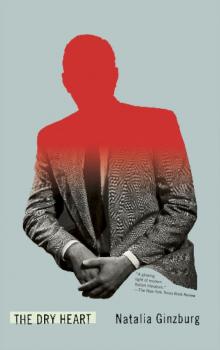 The Dry Heart
The Dry Heart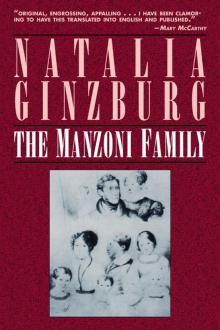 The Manzoni Family
The Manzoni Family A Place to Live
A Place to Live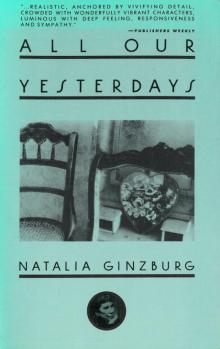 All Our Yesterdays
All Our Yesterdays The Little Virtues
The Little Virtues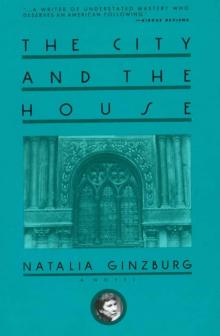 The City and the House
The City and the House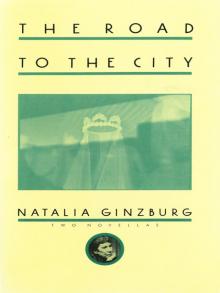 The Road To The City
The Road To The City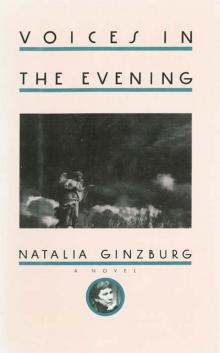 Voices In The Evening
Voices In The Evening